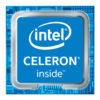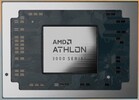Intel Celeron N4500 vs AMD Athlon Silver 3050U vs AMD Athlon Gold 3150U
Intel Celeron N4500
► remove from comparison
The Intel Celeron N4500 is a dual-core SoC of the Jasper Lake series that is primarily intended for inexpensive notebooks and was announced in early 2021. The two Tremont CPU cores clock between 1.1 and 2.8 GHz (single core Burst) and offer no HyperThreading. The N4500 uses 1.5 MB L2 and 4 MB L3 cache. The chip is manufactured on the first-gen 10 nm Intel process.
Architecture
The processor architecture is called Tremont and a complete redesign compared to the old Golmont Plus cores in the predecessor. According to Intel, the single thread performance of a core could is up two 30% better on average (10 - 80% in all tests of SPECint and SPECfp).
Features
In addition to the dual-core CPU block, the SoC integrates a 16 EU Intel UHD Graphics GPU clocked from 350 - 750 MHz and a dual-channel DDR4 / quad-channel LPDDR4(x) memory controller (up to 16 GB, up to 2933 MHz). The chip now also partly integrates Wi-Fi 6 (Gig+), 8 PCIe 3.0 lanes, 14 USB 2.0/ 3.2 ports and two SATA 6.0 ports. The package got bigger and measures 35 x 24 mm (compared to 25 x 24 mm for the N5030 e.g.). The SoC is directly soldered to the mainboard (BGA) and can't be easily replaced.
Performance
The average N4500 in our database shapes up to be a fairly slow processor, its multi-thread benchmark scores only just matching those of the Core i3-4010U. (The latter saw the light of day in 2013 as a lower mid-range, dual-core CPU designed for use in ultraportable laptops.) In other words, expect the Celeron to be painfully slow in all but the most basic activities.
You mileage may vary depending on how high the CPU power limits are.
Power consumption
Like most N-class Intel chips, the Celeron has a default TDP (also known as the long-term power limit) of 6 W. This is not much at all and thus good enough for passively cooled tablets, laptops, mini-PCs.
The Celeron N4500 is built with Intel's 2nd generation 10 nm process (not 10 nm SuperFin or Intel 7) for low, as of mid 2023, energy efficiency.
AMD Athlon Silver 3050U
► remove from comparison
The AMD Athlon Silver 3050U is a mobile processor for thin and light entry level laptops. It is based on the Picasso series (e.g. Ryzen 3000U APUs) and offers two Zen cores clocked at 2.3 to 3.2 GHz without SMT (two threads at once) and 4 MB of L3 Cache. The integrated graphics card is called Radeon RX Vega 2 and offers only 2 CUs (128 shaders) clocked at up to 1,100 MHz.
In Chromebooks, AMD calles the APU AMD Athlon Silver 3050C, but with the exact same specifications (and performance).
Performance
We have not tested a single system built around the 3050U, as of August 2023. Expect the chip to be just a few percentage points slower than the Athlon 3150U (two Zen cores, 4 threads, up to 3.3 GHz). This kind of performance should suffice for most day-to-day tasks but not much more than that.
Power consumption
This Athlon series chip has a default TDP of 15 W (also known as the long-term power limit). Laptop makers are free to change that to anything between 12 W and 25 W with clock speeds and peformance changing accordingly as a result. Either way, that's a tad too high to allow for passively cooled designs.
Last but not the least, the APU is built with a 14 nm process leading to poor, as of early 2023, energy efficiency.
AMD Athlon Gold 3150U
► remove from comparison
The AMD Athlon Gold 3150U is a mobile processor for thin and light entry level laptops. It is based on the Dali series (Raven Ridge Dual Core) and offers two Zen cores clocked at 2.6 to 3.3 GHz with SMT (four threads at once) and 4 MB L3-Cache. The integrated graphics card is called Radeon RX Vega 3 and offers only 3 CUs (192 Shaders) clocked at up to 1000 MHz.
In Chromebooks, AMD calles the APU AMD Athlon Gold 3150C, but with the exact same specifications (and performance).
Performance
The average 3150U in our database is in the same league as the Core i3-10110U, as far as multi-thread benchmark scores are concerned. In other words, this is an entry-level chip, as of mid 2022. While not slow by any means, it is anything but fast, either.
Your mileage may vary depending on how high the CPU power limits are and how competent the cooling solution of your system is.
Power consumption
The Athlon has a default TDP, also known as the long-term power limit, of 15 W that laptop makers are free to change to anything between 12 W and 25 W with clock speeds and performance changing accordingly as a result. Most will go for a higher value to reach higher performance levels. Either way, an active cooling solution will be needed to dissipate the heat.
The AMD 3150U is built with a 14 nm manufacturing process resulting in low, as of early 2023, energy efficiency.
| Model | Intel Celeron N4500 | AMD Athlon Silver 3050U | AMD Athlon Gold 3150U | ||||||||||||||||||||||||||||||||||||||||||||
| Series | Intel Jasper Lake | AMD Picasso (Ryzen 3000 APU) | AMD Picasso (Ryzen 3000 APU) | ||||||||||||||||||||||||||||||||||||||||||||
| Codename | Jasper Lake | Dali (Zen) | Dali (Zen) | ||||||||||||||||||||||||||||||||||||||||||||
| Series: Picasso (Ryzen 3000 APU) Dali (Zen) |
|
|
| ||||||||||||||||||||||||||||||||||||||||||||
| Clock | 1100 - 2800 MHz | 2300 - 3200 MHz | 2400 - 3300 MHz | ||||||||||||||||||||||||||||||||||||||||||||
| L2 Cache | 1.5 MB | 1 MB | 1 MB | ||||||||||||||||||||||||||||||||||||||||||||
| L3 Cache | 4 MB | 4 MB | 4 MB | ||||||||||||||||||||||||||||||||||||||||||||
| Cores / Threads | 2 / 2 | 2 / 2 | 2 / 4 | ||||||||||||||||||||||||||||||||||||||||||||
| TDP | 6 Watt | 15 Watt | 15 Watt | ||||||||||||||||||||||||||||||||||||||||||||
| Technology | 10 nm | 14 nm | 14 nm | ||||||||||||||||||||||||||||||||||||||||||||
| max. Temp. | 105 °C | 95 °C | 95 °C | ||||||||||||||||||||||||||||||||||||||||||||
| Socket | BGA1338 | FP5 | FP5 | ||||||||||||||||||||||||||||||||||||||||||||
| Features | DDR4-2933/LPDDR4x-2933 RAM, PCIe 3, GNA, MMX, SSE, SSE2, SSE3, SSSE3, SSE4.1, SSE4.2, SMEP, SMAP, EIST, TM1, TM2, Turbo, SST, AES-NI, RDRAND, RDSEED, SHA | DDR4-2400 RAM, PCIe 3, MMX, SSE, SSE2, SSE3, SSSE3, SSE4A, SSE4.1, SSE4.2, AVX, AVX2, BMI2, ABM, FMA, ADX, SMEP, SMAP, CPB, AES-NI, RDRAND, RDSEED, SHA, SME | DDR4-2400 RAM, PCIe 3, MMX, SSE, SSE2, SSE3, SSSE3, SSE4A, SSE4.1, SSE4.2, AVX, AVX2, BMI2, ABM, FMA, ADX, SMEP, SMAP, SMT, CPB, AES-NI, RDRAND, RDSEED, SHA, SME | ||||||||||||||||||||||||||||||||||||||||||||
| iGPU | Intel UHD Graphics (Jasper Lake 16 EU) (350 - 750 MHz) | AMD Radeon RX Vega 2 ( - 1100 MHz) | AMD Radeon RX Vega 3 ( - 1000 MHz) | ||||||||||||||||||||||||||||||||||||||||||||
| Architecture | x86 | x86 | x86 | ||||||||||||||||||||||||||||||||||||||||||||
| Announced | |||||||||||||||||||||||||||||||||||||||||||||||
| Manufacturer | ark.intel.com | www.amd.com | www.amd.com | ||||||||||||||||||||||||||||||||||||||||||||
| L1 Cache | 192 KB | 192 KB | |||||||||||||||||||||||||||||||||||||||||||||
| Transistors | 4500 Million | 4500 Million |


 Deutsch
Deutsch English
English Español
Español Français
Français Italiano
Italiano Nederlands
Nederlands Polski
Polski Português
Português Русский
Русский Türkçe
Türkçe Svenska
Svenska Chinese
Chinese Magyar
Magyar